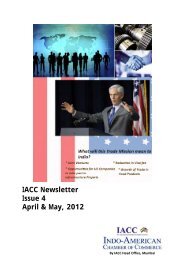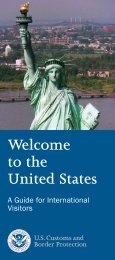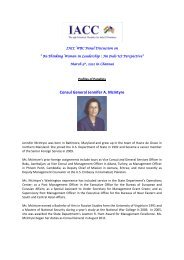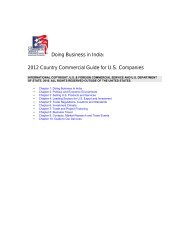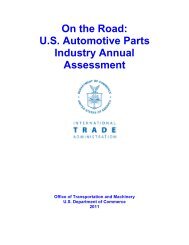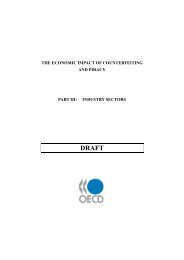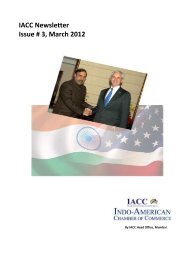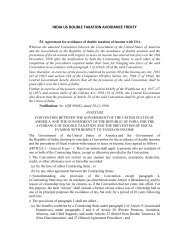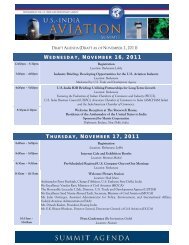Importing into the United States - Indo-American Chamber Of ...
Importing into the United States - Indo-American Chamber Of ...
Importing into the United States - Indo-American Chamber Of ...
Create successful ePaper yourself
Turn your PDF publications into a flip-book with our unique Google optimized e-Paper software.
If <strong>the</strong> change required by this determination<br />
results in a rate of duty more favorable to an<br />
importer, <strong>the</strong> entry is liquidated accordingly<br />
and a refund is authorized for <strong>the</strong> applicable<br />
amount of <strong>the</strong> deposited estimated duties. On<br />
<strong>the</strong> o<strong>the</strong>r hand, a change may be necessary<br />
which imposes a higher rate of duty. For<br />
example, a claim for an exemption from duty<br />
under a free-rate provision or under a conditional<br />
exemption may be found to be insufficient<br />
for lack of <strong>the</strong> required supporting documentation.<br />
In this situation, <strong>the</strong> importer will<br />
be given an advance notice of <strong>the</strong> proposed<br />
duty rate increase and an opportunity to validate<br />
<strong>the</strong> claim for a free rate or more favorable<br />
rate of duty.<br />
If <strong>the</strong> importer does not respond to <strong>the</strong><br />
notice, or if <strong>the</strong> response is found to be without<br />
merit, entry is liquidated in accordance with<br />
<strong>the</strong> entry as corrected, and <strong>the</strong> importer is<br />
billed for <strong>the</strong> additional duty. The port may<br />
find that <strong>the</strong> importer’s response raises issues<br />
of such complexity that resolution is warranted<br />
by a Customs Headquarters decision through<br />
<strong>the</strong> internal advice procedure. Internal advice<br />
from Customs Headquarters may be requested<br />
by local Customs officers on <strong>the</strong>ir own initiative<br />
or in response to a request by <strong>the</strong> importer.<br />
PROTESTS<br />
After liquidation, an importer may still<br />
pursue, on Customs Form 19 (19 CFR 174), any<br />
claims for an adjustment or refund by filing a<br />
protest within 90 days after liquidation. In<br />
order to apply for a Headquarters ruling, a<br />
request for fur<strong>the</strong>r review must be filed with<br />
<strong>the</strong> protest. The same Form 19 can be used for<br />
this purpose. If filed separately, application for<br />
fur<strong>the</strong>r review must still be filed within 90 days<br />
of liquidation. However, if a ruling on <strong>the</strong> question<br />
has previously been issued in response to a<br />
request for a decision on a prospective transaction<br />
or a request for internal advice, fur<strong>the</strong>r<br />
review will ordinarily be denied. If a protest is<br />
denied, an importer has <strong>the</strong> right to litigate <strong>the</strong><br />
matter by filing a summons with <strong>the</strong> U.S. Court<br />
of International Trade within 180 days after<br />
denial of <strong>the</strong> protest. The rules of <strong>the</strong> court and<br />
o<strong>the</strong>r applicable statutes and precedents determine<br />
<strong>the</strong> course of customs litigation.<br />
While <strong>the</strong> Customs Service’s ascertainment<br />
of dutiable status is final for most purposes<br />
at <strong>the</strong> time of liquidation, a liquidation is<br />
not final until any protest which has been filed<br />
against it has been decided. Similarly, <strong>the</strong><br />
administrative decision issued on a protest is<br />
not final until any litigation filed against it has<br />
become final.<br />
Entries must be liquidated within one year<br />
of <strong>the</strong> date of entry unless <strong>the</strong> liquidation needs<br />
to be extended for ano<strong>the</strong>r one-year period not<br />
to exceed a total of four years from <strong>the</strong> date of<br />
entry. The Customs Service will suspend liquidation<br />
of an entry when required by statute or<br />
court order. A suspension will remain in effect<br />
until <strong>the</strong> issue is resolved. Notifications of<br />
extensions and suspensions are given to<br />
importers, surety companies, and customs brokers<br />
who are parties to <strong>the</strong> transaction.<br />
28. CONVERSION OF CURRENCY<br />
The conversion of foreign currency for<br />
customs purposes must be made in accordance<br />
with <strong>the</strong> provisions of 31 U.S.C. 5151. This section<br />
states that Customs is to use rates of<br />
exchange determined and certified by <strong>the</strong> Federal<br />
Reserve Bank of New York. These certified<br />
rates are based on <strong>the</strong> New York market buying<br />
rates for <strong>the</strong> foreign currencies involved.<br />
In <strong>the</strong> case of widely used currencies, rates<br />
of exchange are certified each day.<br />
The rates certified on <strong>the</strong> first business<br />
day of each calendar quarter are used<br />
throughout <strong>the</strong> quarter except on days when<br />
fluctuations of five percent or more occur, in<br />
which case <strong>the</strong> actual certified rates for those<br />
days are used. For infrequently used currencies,<br />
<strong>the</strong> Federal Reserve Bank of New York certifies<br />
rates of exchanges upon request by Customs.<br />
The rates certified are only for <strong>the</strong><br />
currencies and dates requested.<br />
IMPORTING INTO THE UNITED STATES<br />
55



